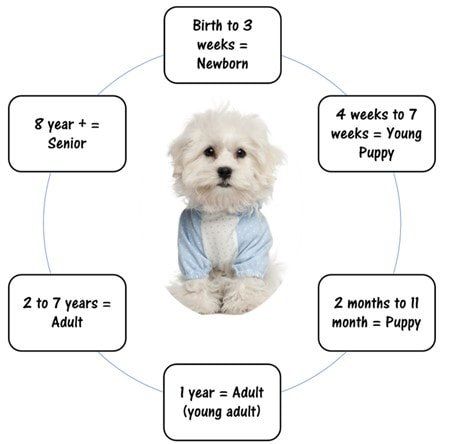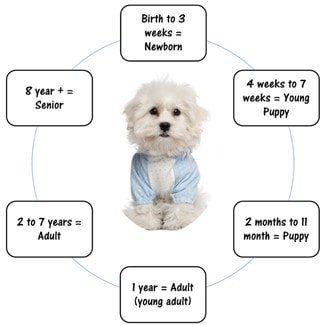Maltese Age
Overview
Dogs age much faster than humans, and unfortunately live shorter lives. While a very general method of estimating a dog's human age equivalent is to say that each year equals 7 human years, this is not exact for all dogs.
This is because toy sized dogs like the Maltese and larger dogs age differently.
In addition, the rate at which a dog ages varies depending on which stage he is in, with the biggest jump being during the first year of puppy-hood.
Here, we'll go over:
- The Maltese dog to human age equivalent
- The different life stages that a Maltese goes through and what to expect at each phase
Milo, 11 months old
Photo courtesy of Urvi Sedani
Age Equivalency
Small toys breed like the Maltese age much faster than medium and large sized dogs. The following will show how old in human years a Maltese is:
Maltese Years = Human Years
1 15 - Dogs age very quickly during the first year, there is a jump equal to about 15 human yrs.2 24 - The second year, a dog ages about 9 human years.3 29 - Starting the 3rd year, a Maltese will age about 5 human years for each year of his life.4 345 396 447 598 649 6910 7411 7912 84 - 12-years-old is the lower end of this breed's expected life span, equal to 84 human yrs.13 8914 94 - 14-years-old is the high end of this breed's expected life span, equal to 94 human yrs.15 99 - Maltese can live longer to 15 years or more.
Milestones as a Maltese Ages
Birth, 1 day old:
A 1-day-old newborn only weighs a few ounces. Pups cannot see right now because the eyelids are shut tightly; this is because optical nerves are still developing and the eye itself is still forming.
Newborn puppies also cannot hear yet.
Muscles and coordination do not allow for walking; however they can wiggle and crawl to nestle close to the dam.
Up to 3 weeks old:
These first few weeks are ones of dramatic changes. By about the 2 week mark, eyes open. Also, hearing comes in. By 3 weeks, pups are trying to walk; it can take several days to a week for a young Maltese puppy to find his gait and walk steadily.
There has been continuous weight gain each day, and the pups are still dependent on the dam's milk.
4 to 7 weeks:
This is also a time of changes. Much more mobile now, Maltese young puppies are romping and playing with their littermates.
This is also the age at which weaning starts. Around the end of week 4 to the beginning of week 5, the dam will nurse less, and the pup should be weaned onto solid foods. By the 7 week mark, the pup will be fully weaned and eating solid food.
8 weeks:
In most states, a puppy needs to be at least 8 weeks old to be sold to new home. This is also the age that milk teeth are coming in.
4 to 5 months:
Teething begins. The 28 milk teeth begin falling out and will be replaced with 42 adult teeth.
4 to 9 months: Puberty begins. Females have their first heat cycle. Males have viable sperm.
1 year:
Maltese are adults at the 1 year mark.
Up to 7 years: In years 1 through 7, a Maltese is in his/her prime.
8 years:
A Maltese is now a senior. There is a very gradual slowing down; most Maltese do not start to show their age until the 10-year mark.

There are a lot of parts that all come together for optimum comfort, health, safety, and happiness.
This is a great round-up of all the important elements of feeding, grooming, coat care, and more.

What you decide to feed your Maltese will have a direct impact on both his current health and for years to come. Far too often, inferior brands cause issues such as upset stomach and affect both skin and coat.
See helpful feeding guidelines, schedules, and tips for making sure that your Maltese is properly fueled.
Spotlight Article
This involves both removing possible triggers and then using an effective stain remover

-min-450x169-480w.jpg)






-min-180x187-344w.jpg)

